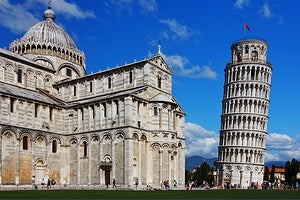How stable are the buildings where we live and work? Our homes rest on concrete foundations about a foot thick and twelve feet deep. The foundations of skyscrapers can be up to 20 feet thick and 280 feet deep.
That’s a lot of concrete. And a new genetically-engineered soil is about to double its strength and durability.
Concrete foundations exist partly to protect against land subsidence, which occurs when groundwater is withdrawn through drainage, underground mining, thawing permafrost, or other causes.

Some of the more well-known buildings on subsiding land are the Leaning Tower of Pisa and Mexico City’s Metropolitan Cathedral. These mostly serve as good photo spots for tourists, but in areas that aren’t as closely monitored, land subsidence can present a serious danger.
The creation of a concrete-repairing bacteria by British students has inspired scientists to develop biocement, a material that genetically-engineered soil microbes would produce in response to changing pressures in soil to automatically reinforce the land under foundations.
Here’s how the concrete-repairing function works.
When the bacteria Bacillus subtilis is added to soil, it produces an enzyme called urease. That enzyme causes the organic compound urea to break down into ammonium and carbonate, increasing the pH in the surrounding environment. Calcium carbonate accumulates at the cells’ surface, and when there’s enough of it, you get a calcite deposit.
Growth of the bacteria is triggered by the specific pH of the concrete they’re used on, which means they start growing only once they’ve made contact with concrete. Once the cells have germinated, they seep into the cracks in the concrete and begin to clump together at the bottom.
This clumping activates the concrete repair process, and the cells differentiate to produce three types of material: calcium carbonate, reinforcing fibers, and a binding agent. The cells have a built-in self-destruct gene preventing them from expanding away from the concrete and affecting adjacent objects.
So, bacteria isn’t just something to be scrubbed off our hands or studied in our digestive systems; who’d have thought it could be used to reinforce buildings from inside their own foundations?
Biocement is being developed to do the same job from the outside in. Cells engineered to respond to pressure changes are added to soil, and when weight is put on the soil the cells create new material, strengthening the soil and reinforcing the building above it
A biodesign team working on what they call the Computational Colloids project grew a common gut bacterium in surrogate soil then subjected the soil to pressure ten times that experienced at sea level. They identified 122 bacterial genes that increased their activity by at least threefold under the pressure change.
The team then modified the bacterial genome so the DNA responsible for activating one of these genes was attached to a gene for a protein that glows when produced. The microbe glowed more intensely as more pressure was applied to it.
But how is glowing soil of any use?
It’s not. The goal is to create a “thinking soil” by replacing the glowing protein gene with genes that make biocement, essentially creating a self-constructing foundation. Rather than applying concrete-repairing bacteria to foundations, the soil around those foundations would produce the bacteria as needed.
Besides reinforcing buildings in high-risk land subsidence areas, thinking soil could be useful in earthquake zones. After a large earthquake it’s common for buildings to have to be razed, since there’s no easy way to repair the foundations’ cracks and return the buildings to a structurally sound state.
Image credit: Shutterstock



